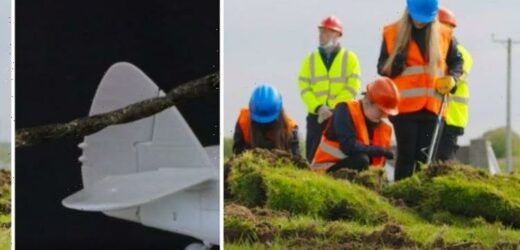Digging for Britain: Expert explains findings at London roundhouse
We use your sign-up to provide content in ways you’ve consented to and to improve our understanding of you. This may include adverts from us and 3rd parties based on our understanding. You can unsubscribe at any time. More info
Near the village of Ballykelly in County Londonderry lies the mystery of a top-secret World War 2 aircraft crash. The Beaufort AW271 came down in April 1942, killing all three men on board. But the debris was swiftly cleared to prevent the highly classified equipment falling into enemy hands.
Jonny McNee, an aviation archaeologist, spent 18 months painstakingly searching for any remaining signs of the crash.
Part of the dig was filmed by camera crews for the BBC documentary ‘Digging for Britain’.
Among the material in the ground was decomposed aluminium.
Aircraft flying from nearby RAF Ballykelly helped protect vulnerable convoys of ships bringing supplies from North America during World War 2.


Hundreds and hundreds of ships were being sunk by the lethal German U-boats, putting the war itself in the balance.
Allied airmen were pushing their lives and their aircraft up to, and sometimes beyond their limits.
Bristol Beaufort’s were torpedo bombers based at Ballykelly airfield. They were used for various experiments, including radar technology to detect U-boats beneath the surface.
The crew of the AW271 were ordered to test if an injured airman could be safely parachuted from a plane by pushing a dummy with a chute out of a hatch.

The exercise went disastrously wrong, however. Mr McNee explained: “The aircraft has come over the top of the rectory when the parachute unfortunately deployed outside and wrapped around the tail of the plane.
“It’s just come over the trees and has belly-flopped down onto the ground and exploded, killing three crew.”
Flt Lt Richard Holsworth 31, Flt Sgt Stanley Chadwick and Flt Lt Duncan Livingstone, both 22, all died.
Mr McNee had been asked to find the crash site by relatives of the crew. Fortunately, no human remains were discovered.
DON’T MISS:
Archaeologists stunned by Ancient Greek device: ‘Rethink history’ [INSIGHT]
Archaeology: Coin discovery could ‘rewrite idea of London’s history’ [QUOTES]
Archaeologists amazed at ‘totally unbroken’ Roman settlement [DISCOVERY]

A large, curved metal edge was discovered in the ground, which Mr McNee suggested might have been a propeller.
Professor Alice Roberts, the programme’s presenter, said: “It’s now beyond doubt that this is the crash site that’s lain forgotten for almost 80 years.”
Numerous other artefacts were discovered and taken away for analysis. Perspex showed very clear evidence of the fire in the plane.
Working at the site alongside Mr McNee were a team of young college students, some of them just a couple of years younger than the tragic crew.

One of the students told the BBC: “We’ve been talking to Richard Holsworth’s daughter and she’s just been telling me that Richard wanted to learn how to fly since he was a young boy.
“It’s just so sad that what he loved so much was his downfall in the end.”
The team found the last remnants of the plane, finally bringing some closure to the families of the crew.
They also discovered what they believe is the burnt parachute cord.
Mr McNee said: “This has definitely been about the human story — for the crew and their memory, for the relatives of the crew, but the most important thing for me, and the level of trust that was put on the team from the family members, was, was there a thorough clean up of the site in 1942?
“Were their loved ones’ remains taken away? And we can say a most definite ‘yes’ to that.”
Months later, they returned to the crash site to honour and commemorate the ultimate sacrifice that the three young men paid.
A memorial stone has been unveiled at the site, and the airmen were remembered by a Royal Air Force flypast.
Digging for Britain is available on BBC iPlayer.
Source: Read Full Article
